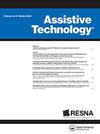理解和探索行动障碍的辅助技术障碍。
IF 2.5
4区 医学
Q1 REHABILITATION
引用次数: 0
摘要
本研究旨在了解及探讨行动障碍人士使用辅助科技的障碍。一项针对300名来自印度北部农村和城市地区的行动不便人士的调查采用了有目的的抽样技术。第一阶段开发了一种有效的测量障碍的工具,而第二阶段将该工具应用于调查。结果显示,可负担性(0.42±0.32)、知晓性(0.46±0.48)和可及性(0.57±0.44)是最常见的障碍。研究结果可以帮助产品设计师和康复专家提高可及性、可负担性和可用性。本文章由计算机程序翻译,如有差异,请以英文原文为准。
Understanding and exploring barriers of assistive technology for individuals with mobility disabilities.
This study aims to understand and explore the barriers to assistive technology for individuals with mobility disabilities. A survey was carried out among 300 people from both rural and urban areas of northern India with mobility disabilities, selected using a purposive sampling technique. Phase I developed a valid tool to measure barriers, while Phase II applied the tool in a survey. Results showed affordability (0.42 ± 0.32), awareness (0.46 ± 0.48), and accessibility (0.57 ± 0.44) as the most common barriers. The findings may assist product designers and rehabilitation specialists in improving accessibility, affordability, and availability.
求助全文
通过发布文献求助,成功后即可免费获取论文全文。
去求助
来源期刊

Assistive Technology
REHABILITATION-
CiteScore
4.00
自引率
5.60%
发文量
40
期刊介绍:
Assistive Technology is an applied, scientific publication in the multi-disciplinary field of technology for people with disabilities. The journal"s purpose is to foster communication among individuals working in all aspects of the assistive technology arena including researchers, developers, clinicians, educators and consumers. The journal will consider papers from all assistive technology applications. Only original papers will be accepted. Technical notes describing preliminary techniques, procedures, or findings of original scientific research may also be submitted. Letters to the Editor are welcome. Books for review may be sent to authors or publisher.
 求助内容:
求助内容: 应助结果提醒方式:
应助结果提醒方式:


